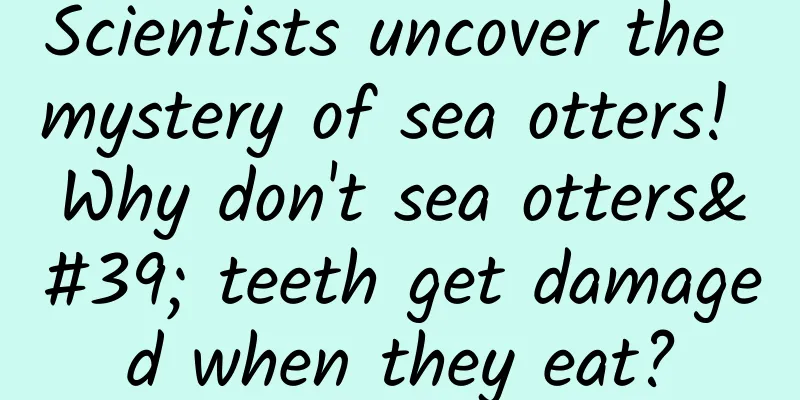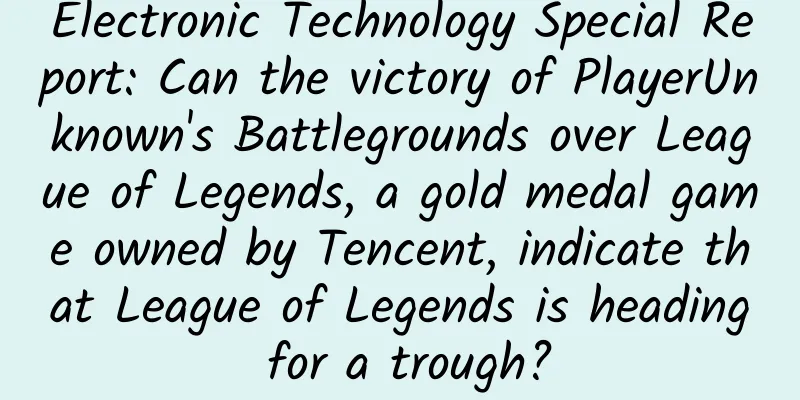Scientists uncover the mystery of sea otters! Why don't sea otters' teeth get damaged when they eat?

|
Produced by: Science Popularization China Author: Su Chengyu (popular science creator) Producer: China Science Expo Editor's note: In order to decode the latest mysteries of life science, the China Science Popularization Frontier Science Project has launched a series of articles called "New Knowledge of Life" to interpret life phenomena and reveal biological mysteries from a unique perspective. Let us delve into the world of life and explore infinite possibilities. Sea urchins are an echinoderm covered with hard spines. Looking at this body of armor that can resist damage, no predator in the wild would dare to touch it. However, the cute sea otter is not afraid of it at all. This is one of its staple foods and it tastes delicious. Sea otter eating sea urchin (Image source: noaa) The spines, or exoskeleton, of sea urchins are primarily composed of calcium carbonate, usually in the form of aragonite. Aragonite is a crystalline form of calcium carbonate (CaCO₃), which is one of two different crystal structures of calcium carbonate, along with calcite. Aragonite has a Mohs hardness of 3.5 to 4, slightly higher than calcite. Because aragonite is hard and tough, it provides good protection for sea urchins. Aragonite is not only found in sea urchins, but also in the shells of marine organisms such as clams, oysters and mussels, which are all food for sea otters. Of course, these are also food for humans, but people don't bite through the shells to eat the meat, after all, it's not worth it to break your teeth. Sea otter eating shellfish (Photo source: PA) Every time I see a sea otter bite off a clam's shell and eat the meat, I feel a phantom pain in my teeth, and when I hear the crunching sound, I always feel like my teeth are going to break. For humans, teeth are mainly composed of enamel, dentin, and pulp. When the teeth act vertically on the hard shell, the enamel will be subjected to great compressive stress. Due to the complexity of chewing movements, the surface of the teeth will also be subjected to a certain amount of shear stress, which will cause microstructural damage to the enamel. Repeated chewing of the hard shell will cause fatigue damage to the enamel, and the gradually accumulated tiny cracks will expand, eventually leading to enamel rupture. Studies have shown that people who frequently chew hard foods (such as nut shells and ice cubes) have a higher rate of tooth damage. In addition, animal experiments and human clinical observations have shown that tooth enamel is prone to cracks and peeling under high stress. Sea otters enjoying a meal of sea urchin (Image source: pinterest) Why don’t sea otters’ teeth get broken off by biting? In 2014, scientists retrieved canines and first molars from frozen sea otter specimens, embedded the roots of the teeth in epoxy resin, and cut longitudinal sections to expose Hunter-Schreger bands (HSBs), a microstructural feature in mammalian tooth enamel. The scientists cut and polished the crown cross-section to a 1-micron finish to ensure a smooth surface. They then placed the sample on a mechanical testing platform and used a tungsten carbide Vickers macro-indenter to press vertically down on the enamel, gradually increasing the load until a scallop-shaped crack appeared on the tooth surface. During the experiment, the scientists recorded the peak force (PF) required for each chipping, as well as the critical chip size (h) from the indentation point to the tooth edge. By measuring 12 experimental chippings, they found that the chip size (h) ranged from 0.16 to 0.79 mm, while the peak force (PF) required ranged from 53 to 605 Newtons. Through linear regression analysis, it can be seen that the slope of sea otter enamel is not significantly different from that of human enamel, but the intercept is significantly higher, indicating that the toughness of sea otter enamel is 2.8 times that of human enamel. (Image source: Reference 2) Finally, the scientists also drew a force-displacement graph and calculated the toughness of sea otter enamel. The results showed that the toughness of sea otter enamel is 2.8 MPa m^0.5, which is significantly higher than human enamel (about 1.0 MPa m^0.5), and its enamel toughness is almost three times that of humans. Obviously, the toughness of sea otter enamel is much stronger than that of human enamel. This is mainly due to the HSB structure in sea otter teeth. The staggered arrangement of HSB can effectively disperse and absorb stress, prevent cracks from extending in a single direction, and thus enhance the toughness of teeth. a shows the overlapping and interlaced structure of the sea otter's enamel; c shows the dense round prism structure of the enamel under an electron microscope (Image source: Reference 2) Scientists have discovered through microscopic observations that the HSB in sea otter enamel extends almost to the surface of the teeth, which means that all cracks involve the interlaced structure, further improving the teeth's resistance to cracking, making the teeth naturally less likely to crack. In human teeth, only larger fractures involve HSB, which is one of the reasons why human teeth have a lower resistance to fracture. Sea otters also use tools to open their shells Tool use is not common in the animal kingdom, but in some species, this behavior brings significant adaptive advantages. Sea otters are one such example. Not only do they have good teeth, but they also use tools such as stones to crack open hard shells and obtain food. In 2023, scientists captured 196 sea otters in the coastal area of central California and installed radio tags on them to track their activities and record the use of tools by each sea otter when foraging. They also regularly examined the teeth of the sea otters to assess their tooth damage and the proportion of dentin exposure. Sea otter using a stone to open its shell (Image source: Reference 1) First, female sea otters who used tools more frequently were able to obtain larger and harder prey. Female sea otters who used tools more than 90% of the time obtained prey that was 197% harder than those who did not use tools. There was no significant correlation between tool use frequency and prey hardness in male sea otters, which may be because male sea otters are larger in size and have stronger bite forces. Second, sea otters that used tools more frequently had less tooth damage. Individuals that used tools more than 50% had 19% (females) and 16% (males) less tooth damage. Of course, there were some exceptions, with 1% to 6% of individuals showing increased tooth damage, possibly because these individuals handled harder prey. Sea otters place rocks on their chests to help them open their shells (Image source: Hakai Magazine) This shows that tool use has an important impact on the foraging and dental health of southern sea otters. Using tools not only helps sea otters obtain more and harder prey, but also reduces tooth damage and maintains dental health. Good teeth mean a smart brain, which is why sea otters don’t break their teeth. References: 1. Chris J. Law et al. ,Tool use increases mechanical foraging success and tooth health in southern sea otters (Enhydra lutris nereis).Science384,798-802(2024).DOI:10.1126/science.adj6608 2. Ziscovici C, Lucas PW, Constantino PJ, et al. Sea otter dental enamel is highly resistant to chipping due to its microstructure[J]. Biology Letters, 2014, 10(10): 20140484. |
<<: Don’t be too serious about expired food? You have ignored the shelf life and storage conditions!
Recommend
Why did Oppenheimer poison his mentor? 23 details in the movie that are easily overlooked
Recently, the movie "Oppenheimer" is be...
700 million years ago, there were no 24 hours in a day on Earth! ?
Author: Huang Xianghong Duan Yuechu In the vast u...
How can marketers quickly understand an industry within 1 week?
Insight comes from understanding. Industry resear...
Amazing! This bird's beak changes color during the breeding season
The arrival of spring is always accompanied by th...
How educational institutions increase followers and traffic through TikTok!
This article introduces the methods used by educa...
Xiaohongshu traffic logic, KOL model, content marketing
This article selects the essence of the course to...
It’s not that it’s harder to get traffic, it’s that you don’t understand your users!
What do users like to pay attention to? How can w...
There are so many benefits to sunbathing for a while every day! It is simply a free "health supplement"
How much Sichuan people love to sunbathe When the...
Sigh! Nearly 8 years after Jobs' death, Apple has lost another soul figure
Recently, Apple announced on its official website...
"59 types of coffee were found to contain carcinogens", so coffee can no longer be drunk safely? The truth is →
Recently, the topic #59 types of coffee all found...
OnePlus completely closes offline stores: input costs and outputs do not match
After a year and a half, OnePlus finally returned...
The “traffic code” of brand self-broadcasting
Nowadays, short videos and live broadcasts are ve...
Netflix aims to disrupt the entire TV industry
In recent months, the media has been heavily invo...
Baidu bidding promotion plan, a must-read for newbies!
Baidu bidding promotion plan is divided into 2 ty...
iQOO 5 review: balanced evolution in all aspects, the first "lightweight" gaming phone in history
A year and a half ago, when the iQOO series of mo...









